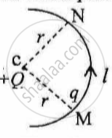Advertisements
Advertisements
Question
Does the charge given to a metallic sphere depend on whether it is hollow or solid? Give reason for your answer.
Solution
No, the charge given to a metallic sphere does not depend on whether it is hollow or solid because all the charge given to both the spheres will appear on the outer surface of the spheres.
APPEARS IN
RELATED QUESTIONS
When a charged comb is brought near a small piece of paper, it attracts the piece. Does the paper become charged when the comb is brought near it?
In Figure 1 below, a charge Q is fixed. Another charge q is moved along a circular arc MN of radius r around it, from the point M to the point N such that the length of the arc MN = l. The work done in this process is:

figure 1
+2 C and +6 C two charges are repelling each other with a force of 12 N. If each charge is given -2 C of charge, then the value of the force will be ______
Let x = πR`(("P"^2 - "Q"^2)/2)`, where P, Q and Rare lengths. The physical quantity x is ______.
Conservation of charges in tribo electric charging _________.
Charge is quantized means ______.
The number of lines of force that radiate outwards from one coulomb of charge is:-
Eight dipoles of charge of magnitude ± e are placed inside a cube. The total electric flux coming out of the cube will be:-
A paisa coin is made up of Al-Mg alloy and weighs 0.75g. It has a square shape and its diagonal measures 17 mm. It is electrically neutral and contains equal amounts of positive and negative charges.
Treating the paisa coins made up of only Al, find the magnitude of equal number of positive and negative charges. What conclusion do you draw from this magnitude?
Consider a coin of Example 1.20. It is electrically neutral and contains equal amounts of positive and negative charge of magnitude 34.8 kC. Suppose that these equal charges were concentrated in two point charges seperated by (i) 1 cm `(∼ 1/2 xx "diagonal of the one paisa coin")`, (ii) 100 m (~ length of a long 6 building) and (iii) 106 m (radius of the earth). Find the force on each such point charge in each of the three cases. What do you conclude from these results?
